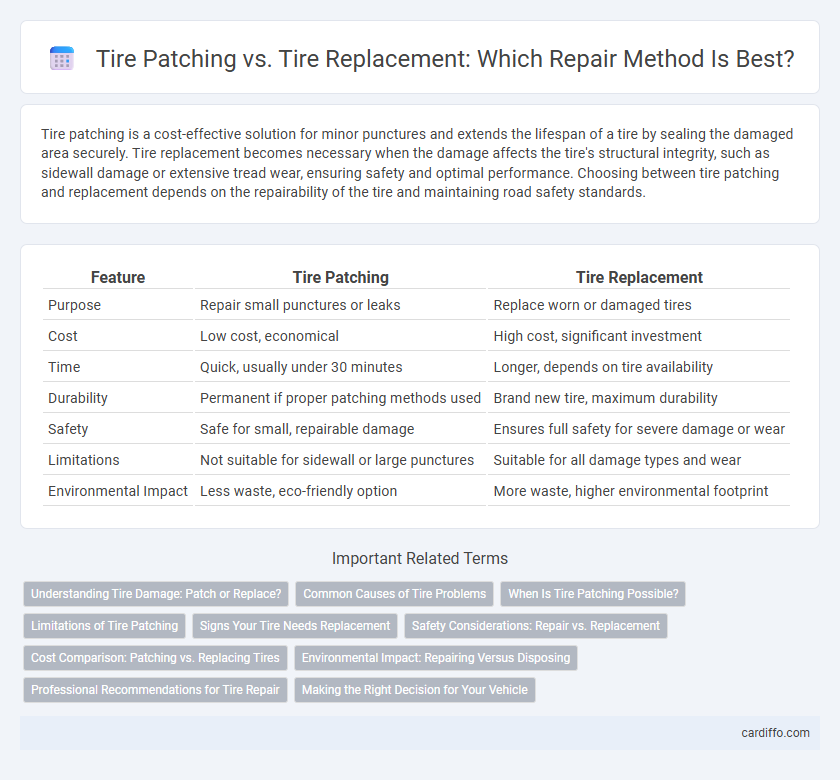Tire patching is a cost-effective solution for minor punctures and extends the lifespan of a tire by sealing the damaged area securely. Tire replacement becomes necessary when the damage affects the tire's structural integrity, such as sidewall damage or extensive tread wear, ensuring safety and optimal performance. Choosing between tire patching and replacement depends on the repairability of the tire and maintaining road safety standards.
Table of Comparison
| Feature | Tire Patching | Tire Replacement |
|---|---|---|
| Purpose | Repair small punctures or leaks | Replace worn or damaged tires |
| Cost | Low cost, economical | High cost, significant investment |
| Time | Quick, usually under 30 minutes | Longer, depends on tire availability |
| Durability | Permanent if proper patching methods used | Brand new tire, maximum durability |
| Safety | Safe for small, repairable damage | Ensures full safety for severe damage or wear |
| Limitations | Not suitable for sidewall or large punctures | Suitable for all damage types and wear |
| Environmental Impact | Less waste, eco-friendly option | More waste, higher environmental footprint |
Understanding Tire Damage: Patch or Replace?
Tire damage severity and location determine whether patching or replacement is appropriate, with punctures in the tread area often suitable for patching while sidewall damage necessitates replacement. Proper inspection for factors like size of the puncture, tire wear, and internal structure integrity is crucial for safety and tire longevity. Professional evaluation ensures that tires meet safety standards, preventing accidents and optimizing vehicle performance.
Common Causes of Tire Problems
Common causes of tire problems include punctures from nails, sharp objects, or road debris that often lead to slow leaks, making tire patching an effective and economical solution for minor damages. Severe tire damage such as sidewall cuts, large punctures, or excessive tread wear necessitates tire replacement to ensure safety and maintain vehicle performance. Proper tire maintenance and regular inspections can help identify issues early and determine whether patching or replacing is the most suitable repair method.
When Is Tire Patching Possible?
Tire patching is possible when the damage is limited to the tread area and the puncture is less than 1/4 inch in diameter, without affecting the sidewall or shoulder of the tire. Repairs must be performed from the inside to ensure a reliable seal and prevent air leaks. If the tire has multiple punctures, sidewall damage, or the structural integrity is compromised, tire replacement is necessary for safety.
Limitations of Tire Patching
Tire patching is effective for small punctures located on the tread area but cannot be used for damages on the sidewall or large gashes exceeding 1/4 inch. Patched tires may have compromised structural integrity, reducing their overall lifespan and increasing the risk of blowouts during high-speed driving. Regular inspections and professional evaluations are essential to determine when full tire replacement is necessary to ensure safety and performance.
Signs Your Tire Needs Replacement
Worn tread depth below 2/32 inch, visible sidewall cracks, and frequent air pressure loss are clear signs your tire needs replacement rather than patching. Tires with extensive punctures or damage beyond the repairable area also require replacement to ensure safety. Monitoring uneven wear patterns caused by alignment or suspension issues helps prevent hazardous tire conditions.
Safety Considerations: Repair vs. Replacement
Tire patching offers a cost-effective solution for minor punctures, but safety considerations demand that repairs are only suitable if the damage is limited to the tread area and less than 1/4 inch in diameter. Replacement becomes essential when sidewall damage, extensive tread separation, or large punctures compromise the tire's structural integrity and risk tire failure. Prioritizing tire replacement ensures optimal vehicle handling, braking performance, and prevents blowouts, significantly enhancing overall road safety.
Cost Comparison: Patching vs. Replacing Tires
Tire patching typically costs between $10 and $30, offering a budget-friendly solution for minor punctures, while tire replacement can range from $100 to $300 or more per tire depending on the brand and tire size. Patching extends the life of the existing tire, reducing immediate expenses, but may not be suitable for sidewall damage or large punctures that compromise safety. Considering long-term value, replacing worn or irreparable tires prevents future costs related to uneven wear, decreased fuel efficiency, and potential accidents.
Environmental Impact: Repairing Versus Disposing
Tire patching significantly reduces environmental impact by minimizing rubber waste and lowering resource consumption compared to tire replacement. Disposing of old tires contributes to landfill overflow and releases harmful chemicals during degradation, whereas repairing extends tire life and supports sustainable waste management. Choosing tire patching over replacement decreases the carbon footprint associated with manufacturing new tires.
Professional Recommendations for Tire Repair
Professional recommendations for tire repair emphasize that tire patching is suitable for small punctures located on the tread area, where the structural integrity remains intact. For sidewall damage, large punctures, or extensive tread wear, tire replacement is advised to ensure safety and maintain optimal vehicle performance. Certified mechanics use diagnostic tools to assess the extent of damage and determine whether patching complies with industry safety standards or if full replacement is necessary.
Making the Right Decision for Your Vehicle
Choosing between tire patching and tire replacement depends on the damage severity, tire age, and driving conditions. Small punctures in the tread area can be safely repaired using professional patching methods that restore tire integrity and extend lifespan. Severe damage, sidewall cracks, or worn-out tires require full replacement to ensure optimal safety, vehicle handling, and performance on the road.
Tire patching vs tire replacement Infographic

 cardiffo.com
cardiffo.com